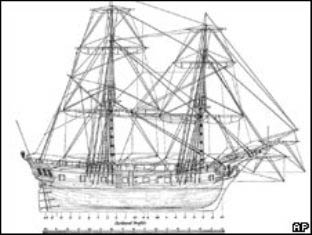HMS Ontario, a British warship, sunk during a storm in Lake Ontario on October 31, 1780, during the American Revolutionary War. In the vast Great Lakes, HMS Ontario is the only completely intact British Warship ever found. She was discovered in 2008 by Jim Kennard and Dan Scoville using side-scan sonar. She rests in 500 feet of water and all the crew of 130 perished. The cold water of Lake Ontario has preserved her well.
In 1780, Ontario was constructed on Carleton Island, a major base for the British during the Revolutionary War, but now part of New York, on the St Lawrence River. She was operated by the Royal Navy for the Provincial Navy in an armed transport capacity. and contained 22 guns.
With a length of 80 feet and a 25-foot beam, HMS Ontario weighed 226 tonnes. She was considered a “snow” (square-rigged vessel with two masts)

HMS Ontario was the largest British warship sailing on the Great Lakes at the time. Just five months before she sank, she was launched and was used to transport soldiers, supplies and prisoners from one remote part of New York to the next. She’d never seen a battle.
HMS Ontario sank in a storm on October 31, 1780, while underway from Fort Niagara to Oswego. News of Ontario’s sinking was kept secret for a number of years to hide the naval loss.
In the search for HMS Ontario in late May 2008, side-scan sonar technology was used. A promising wreck was discovered between Niagara and Rochester, New York, in a region of Lake Ontario where the depth exceeds 492 feet (150 m). A broad sailing ship resting upright at an angle, with two masts reaching at least 70 feet (21 m) above the bottom of the lake, was clearly seen in the sonar imagery. The high-resolution photos showed the remains on each mast of two crow’s nests, strongly suggested that the brig-sloop Ontario was the sunken vessel. A remotely operated underwater vehicle was deployed and confirmed the identity of the ship in early June 2008 due to the depth limits for diving on this shipwreck.
Kennard and Scoville claim that, after being on the bottom for 230 years, the cold, freshwater of Lake Ontario, combined with a lack of light and oxygen, delayed decomposition and accounted for the ship being found relatively intact. The discoverers of the shipwreck informed the New York State Office of Historic Preservation of the shipwreck, but the precise location of the wreck was not publicly disclosed.
The wreck still belongs to the United Kingdom and is a war grave.





